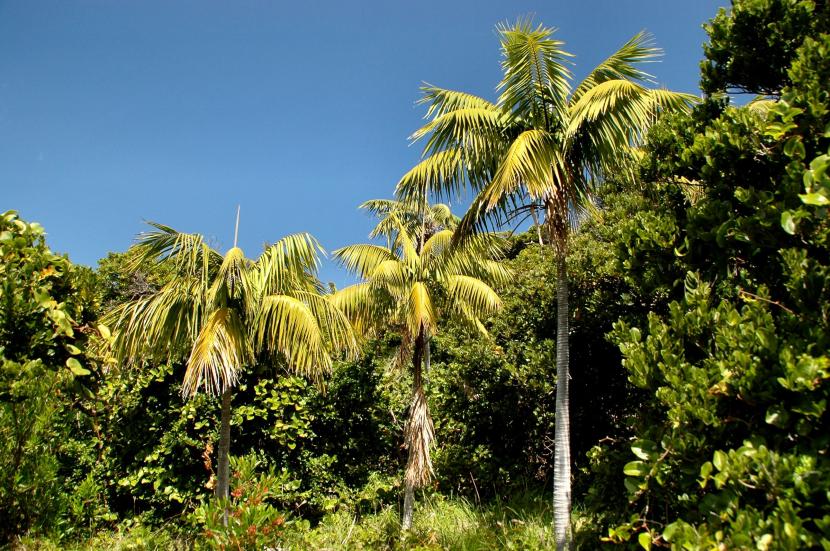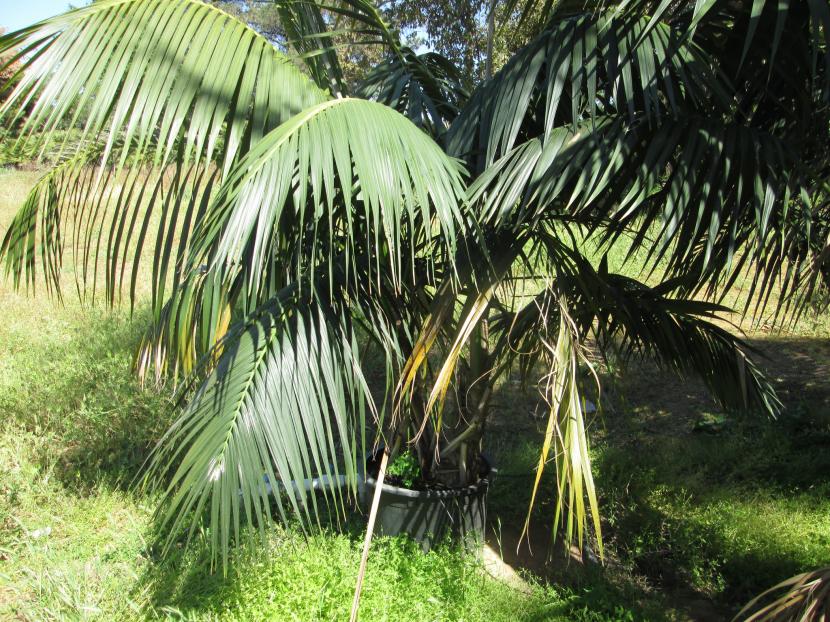
La Kentia It is one of the most cultivated palm trees in the world, both to decorate the interior and exterior of the home. Although it has a slow growth rate, it is one of those plants so beautiful that many people do not care having to wait years to get their specimen to grow as much as any of the ones in the image.
Its maintenance is not very difficult, but it is true that it is very important to take into account several things so that problems do not arise; or in case they appear, know how to solve them as soon as possible.
Origin and characteristics

The kentia, whose scientific name is Howea forsteriana, is an endemic palm to Lord Howe Island. It is unicaule, that is, it has a single trunk, which is cylindrical, ringed from 10 to 15 meters high by about 13 cm in diameter.. The crown is made up of pinnate, flat, ascending, dark green leaves with a length of up to 2 meters.
The flowers are grouped in long, thin, sloping branched inflorescences. The fruits are ovoid, first brown and then red.
What are their cares?
If you want to have a copy, we recommend that you provide it with the following care:
Location
- Body exterior:: in semi-shadow.
- Interior: in a room with plenty of natural light.
Earth

- Garden: fertile, with good drainage.
- Flower pot: universal culture substrate mixed with 30% perlite.
Irrigation
Frequent in summer, moderate the rest of the year. Frequency will vary depending on weather and location, but In general, you have to water the kentia about 3 times a week in the hottest season, and once a week the rest. In case of having it inside the house, the waterings should be somewhat more widely spaced.
Use rainwater or without too much lime. If the one we have is very, very hard, the ideal would be to fill a bucket and let it sit overnight. The next day we can use the one in the upper half of said cube, since the heavy metals will have remained in the depths.
Subscriber
From spring to summer it must be paid with a specific fertilizer for palm trees following the indications specified on the product packaging. It is also highly recommended to pay from time to time with Organic fertilizers, especially if it is planted on the ground. In this way, you will have better growth and development.
Multiplication
Kentia multiplies only by seeds in spring. The step by step to follow is the following:
- First, a clear, sealable plastic bag of universal growing medium is filled.
- Second, the substrate is moistened, ensuring that it does not over water (in the event that this occurs, it should be removed).
- Third, the seeds are thrown into the bag and covered with a little more substrate -this previously moistened-.
- Fourth and last, the bag is placed near a heat source, where it can be around 20-22 degrees Celsius.
Thus, keeping the substrate always moist but not flooded, the seeds will germinate in 1 or 2 months.
Pests

It is quite resistant, but if the growing conditions are not the most suitable it can be affected by:
- Red spider: it is a mite that feeds on the cells of the leaves, especially the most tender ones. It is fought with acaricides.
- Cottony mealybug: it is a parasite that we will also find in the leaves, from where it feeds. They can be removed by hand, with a brush dipped in pharmacy alcohol or with an anti-cochineal insecticide.
- paysandisia: it is a butterfly whose larvae can destroy the interior of the palm tree trunk and the leaves in a matter of days in hot weather. They are fought with Chlorpyrifos and Imidacloprid. Here You have more information.
- Red weevil: it is a weevil whose larvae excavate galleries in the trunk. It can be fatal to the plant. It is fought with Chlorpyrifos and Imidacloprid; and it can be prevented with Natural medicine.
- Trips: they are parasites like earwigs but much smaller, black in color that adhere to the underside of the leaves, where they leave their residues (they are like tiny black balls). They can be removed by hand if they are few or the palm tree is small, or with anti-thrips insecticides.
Management
If overwatered, fungi, such as Cylindrocladium or Stigmina, can appear. The symptoms are:
- Gray, pink, or white powder or mold
- Apex rot (newer leaf)
- Rapid browning of the leaves
It is treated with fungicides, but if the base of the trunk or the apex is rotten, nothing can be done. Therefore, it is very important to control the risks.
Pruning
It should not be prunedJust remove completely dry leaves in late winter or early fall.
Rusticity
It is a plant that withstands cold and frost down to -5ºC, but it lives better in those areas that are warmer.

And you, do you have any kentia?